The land covered in sacred gold
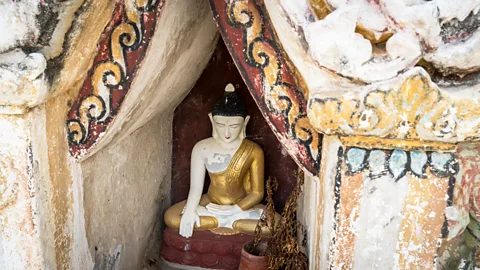 Vivien Cumming
Vivien CummingIn Myanmar, gold is so sacred that it can be found in anything from traditional medicine to face creams, and it’s sometimes even added to drinks or food.
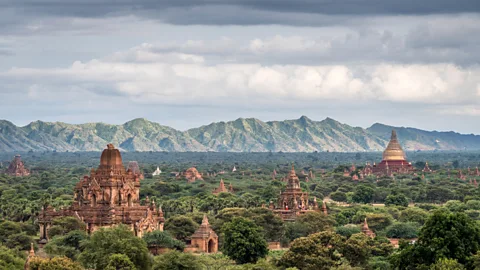 Vivien Cumming
Vivien CummingIn surrounding countries, Myanmar is known as ‘the golden land’, and when you fly into cities such as Mandalay and Yangon it’s easy to understand why. From the sky you can see glittering golden stupas and pagodas dotted throughout the countryside and nestled among busy city streets.
On the ground, you can’t go far without coming across a gilded Buddhist temple; the largest are on hills in town centres and the smallest are tucked at the base of old trees outside people’s homes. Gold adorns almost all of them, and there are thousands of them throughout the country.
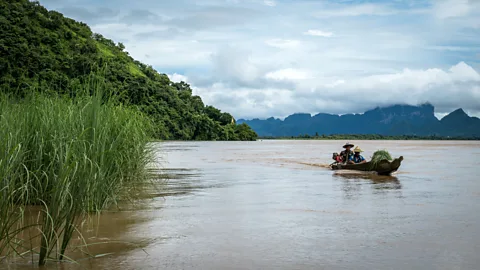 Vivien Cumming
Vivien CummingThe Irrawaddy River flows through the heart of the golden land. Its banks are quintessential Myanmar (also known as Burma), with massive temples on hills, monsoon clouds above jungle-covered mountains and floodplains with houses teetering on stilts above the water line.
According to Mandalay Business Forum, there are more than 700 golden temples on Mandalay’s surrounding hills, which can be seen from the river. And around the city of Bagan, further down the river, the remains of 2,200 temples and pagodas are scattered across the horizon.
At its height between the 11th and 13th Centuries, the Kingdom of Pagan (now known as Bagan) was home to more than 10,000 temples. It was during this time that Buddhism expanded in Myanmar, though the origin of Buddhism dates back more than 2,000 years.
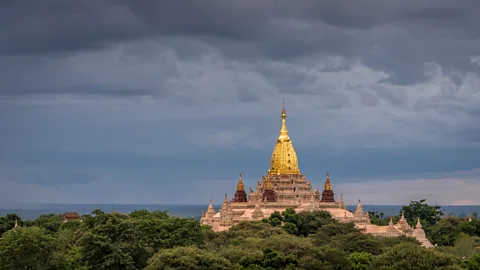 Vivien Cumming
Vivien CummingIn Myanmar, gold is sacred. Almost 90% of the population is Buddhist, according to Harvard Divinity School’s Religious Literacy Project, and gold is of huge significance for them as it represents the sun, which is associated with qualities such as knowledge and enlightenment. The Burmese people make offerings to Buddha by decorating temples throughout the country with gold.
“Gold is very precious in Myanmar because we can find [it] in many of the rivers,” said Sithu Htun, a local guide from Yangon who has travelled all over the country. “It’s part of our land – very easy to find – and that’s why we donate it to the Buddha.”
But it’s not just used at temples; the attachment to gold runs so deep that it can also be found in many other things from traditional medicine to face creams, and it’s sometimes even added to drinks or food. On special occasions, gold leaf can be added to steamed rice and beans, and local spirits are shaken with gold leaf to drink on special occasions. Gold is literally part of the land and people.
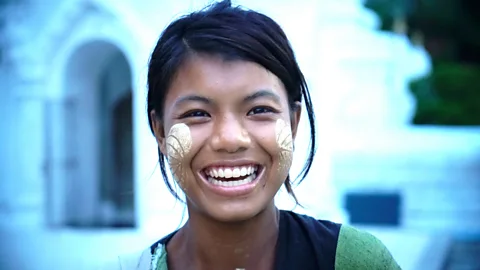 Vivien Cumming
Vivien CummingWe use banana and gold leaf for facemasks. It’s very good for the skin; after three to five minutes the gold is gone. I think it goes into our skin and gives us our smiles,” Htun said.
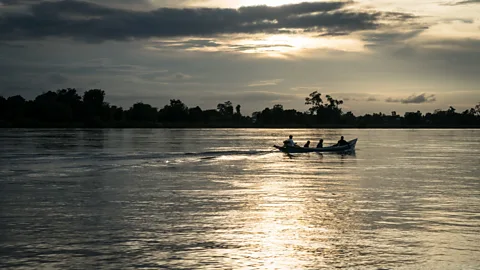 Vivien Cumming
Vivien CummingSome of the main sources of gold are mines in the ground near Mandalay and in sediment found in the Irrawaddy and Chindwin rivers, where local people still pan for gold despite new technologies that speed up the process.
Mercury has been used to isolate the gold from sand in the river bottom, but mercury poisoning is affecting fish populations and the health of the people working to isolate the gold. Additionally, the Myanmar Times reports that some damage has been done by illegal mining practices.
However, according to the Independent, there are a number of community projects that are working to upgrade mining practices to protect the environment and people.
 Vivien Cumming
Vivien CummingIn central Mandalay, there is an area called ‘the gold leaf beating quarter’, where men spend the days hammering gold into fine leaf in temperatures of more than 30C in the summer and upwards of 70% humidity.
The men use 7lb hammers to beat the gold layered between bamboo paper over a large rock. The beaten gold is then cut into smaller pieces and beaten again – a total of three times, with the final time lasting five hours and requiring the physical strength of several men.
“Most of the gold leaf workshops are family businesses; the men do the pounding and the women cut the leaf into squares to be sold,” Htun explained.
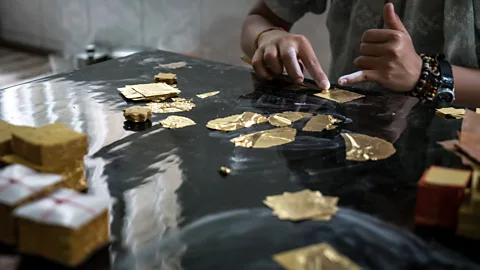 Vivien Cumming
Vivien CummingOnce the gold leaf has been cut into squares by the women, it is packaged between bamboo papers to be sold as offerings to the Buddha. Women also apply gold leaf to carved wooden ornaments of Buddha or animals such as elephants that are initially lacquered in black.
And gold isn’t just applied to temples or ornaments. “Sometimes we apply gold leaf to bananas and coconuts to make offerings to spirits,” said Htun.
People even apply it to themselves by adding a paste of ground wood called thanakha to their faces as sun protection – sometimes applying it in decorative patterns – and adding gold leaf to illuminate the skin.
 Vivien Cumming
Vivien CummingIn the past and still today, gold is used as a form of currency in Myanmar. With political and economic instability (particularly with the current Rohingya crisis), gold, unlike Myanmar’s local currency, the kyat, holds its value.
According to locals, many Burmese people don’t use savings s at banks, and instead buy gold, either as an offering to ensure prosperity in their next lives or to keep in the form of jewellery or even little nuggets as insurance in current lives. There are gold shops on street corners in even the smallest towns where these investments can be purchased.
“Since independence in 1948, the country and economy is not very stable,” Htun explained while walking past a gold shop in Mandalay. “That’s why people want to keep gold; it’s safer for the future, a sort of insurance.”
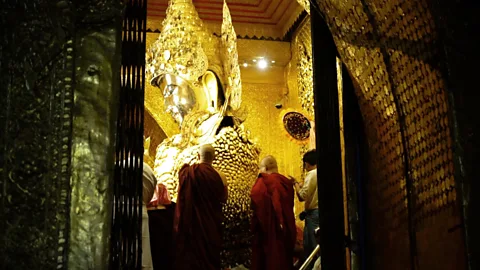 Vivien Cumming
Vivien CummingAfter decades of isolation under an oppressive military regime, Myanmar has only recently emerged as a destination open to visitors. And in tourist areas, Buddhism seems to pervade nearly every aspect of daily life in Myanmar.
In the early mornings, monks and nuns wander the streets and markets searching for offerings of food. Giving is a huge part of Burmese culture, which is evident in the way locals welcome visitors with generosity and kindness, offering cups of tea and biscuits – or even laying on a huge meal, proudly showing all the food they can offer.
“The people are very nice and very friendly – they always smile,” Htun said. They just want to help; they don’t want to get anything from you.”
 Vivien Cumming
Vivien CummingAt 04:00 every morning, Mandalay’s Mahamuni Paya, one of Myanmar’s most sacred temples and considered by Buddhists to be one of the holiest places in the country, is packed with people. Monks perform a ceremony where they wash the face of a big golden Buddha.
People buy gold leaf – which costs 2,000 kyat (about £1) for five, one-inch squares – at stalls in the temple and line up to paste it on the huge Buddha as an offering.
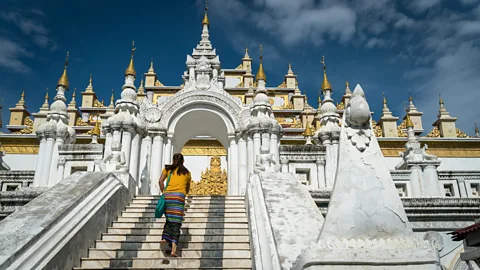 Vivien Cumming
Vivien Cumming“We always want to give more and more to the Buddha – we build more and more temples and pagodas so that we can cover them in the precious gold from our land,” said Htun.
(Text, video and photos by Vivien Cumming; video edited by Joby Newson and Vivien Cumming)
The World’s Rarest is a BBC Travel series that introduces you to unparalleled treasures found in striking places all across the world.
